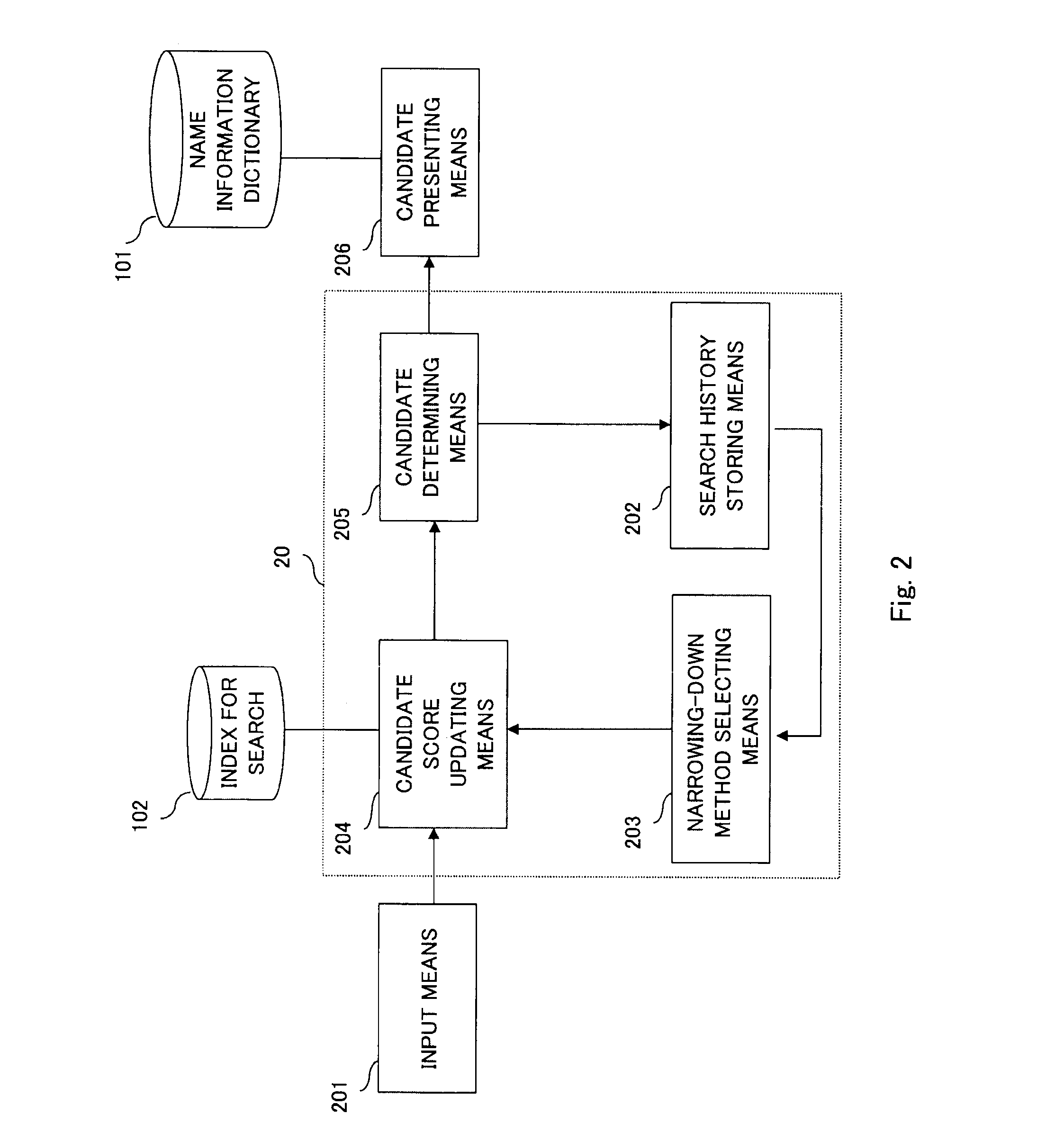Retrieval device
a technology of a retrieval device and a memory card, which is applied in the field of retrieval devices, can solve the problems of long processing time required for reading from secondary storage, and achieve the effect of shortening the computation time and realizing a shorter average computation tim
- Summary
- Abstract
- Description
- Claims
- Application Information
AI Technical Summary
Benefits of technology
Problems solved by technology
Method used
Image
Examples
first embodiment
[0038]FIG. 1 illustrates an overall configuration of a retrieval device according to the present invention. An input section 10 receives an input by way of, for example, text or voice, and, if necessary, refers to a large-vocabulary speech recognition dictionary 103 to convert the input to a format recognizable by a search section 20. The search section 20 refers to an index 102 for search and performs fuzzy search. A presentation section 30 refers to a name information dictionary 101 and presents, to a user, a name obtained as a result of the search made by the search section 20 and related information thereof.
[0039]The name information dictionary 101, the index 102 for search, and the large-vocabulary speech recognition dictionary 103 are created from data of search target. As the search target becomes larger, the name information dictionary 101, the index 102 for search, and the large-vocabulary speech recognition dictionary 103 also become larger in data size, and are thus locat...
second embodiment
[0072]FIG. 9 is a functional block diagram illustrating a configuration of a retrieval device according to a second embodiment of the present invention. The retrieval device according to the second embodiment is additionally provided with means 302 for generating a recognition dictionary for narrowing-down, compared to the retrieval device of the first embodiment. Further, the retrieval device according to the second embodiment is based on the assumption that an input is a voice. Hereinbelow, the same components as those of the first embodiment are denoted by the same numerals as those used in FIG. 2, and description thereof is herein omitted or simplified.
[0073]The large-vocabulary recognition dictionary 103 is a dictionary for speech recognition created in advance for recognizing a search expression of the user with respect to name information to be retrieved. In general, in the speech recognition, as the possibility that the speech recognition dictionary can narrow down words whi...
third embodiment
[0100]FIG. 13 is a functional block diagram illustrating a configuration of a retrieval device according to a third embodiment of the present invention. The retrieval device according to the third embodiment is additionally provided with means 401 for adapting a recognition dictionary for narrowing-down, compared to the retrieval device of the second embodiment. Hereinbelow, the same components as those of the second embodiment are denoted by the same numerals as those used in FIG. 9, and description thereof is herein omitted or simplified.
[0101]The voice input means 301 receives a voice input of the user, and performs speech recognition by referring to the recognition dictionary, to thereby output a character string. As for the recognition dictionary, when there is no search history, the voice input means 301 refers to the large-vocabulary recognition dictionary 103. When there is a search history, based on the narrowing-down method selecting means 203, the voice input means 301 re...
PUM
 Login to View More
Login to View More Abstract
Description
Claims
Application Information
 Login to View More
Login to View More - R&D
- Intellectual Property
- Life Sciences
- Materials
- Tech Scout
- Unparalleled Data Quality
- Higher Quality Content
- 60% Fewer Hallucinations
Browse by: Latest US Patents, China's latest patents, Technical Efficacy Thesaurus, Application Domain, Technology Topic, Popular Technical Reports.
© 2025 PatSnap. All rights reserved.Legal|Privacy policy|Modern Slavery Act Transparency Statement|Sitemap|About US| Contact US: help@patsnap.com



